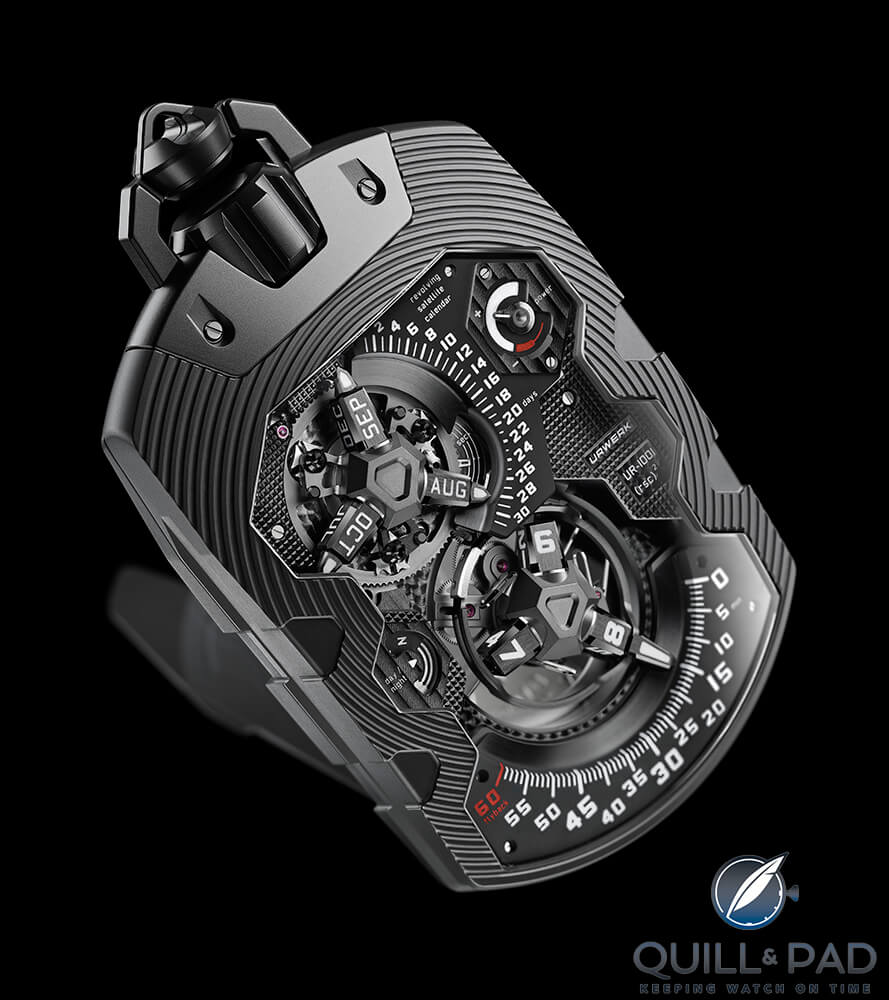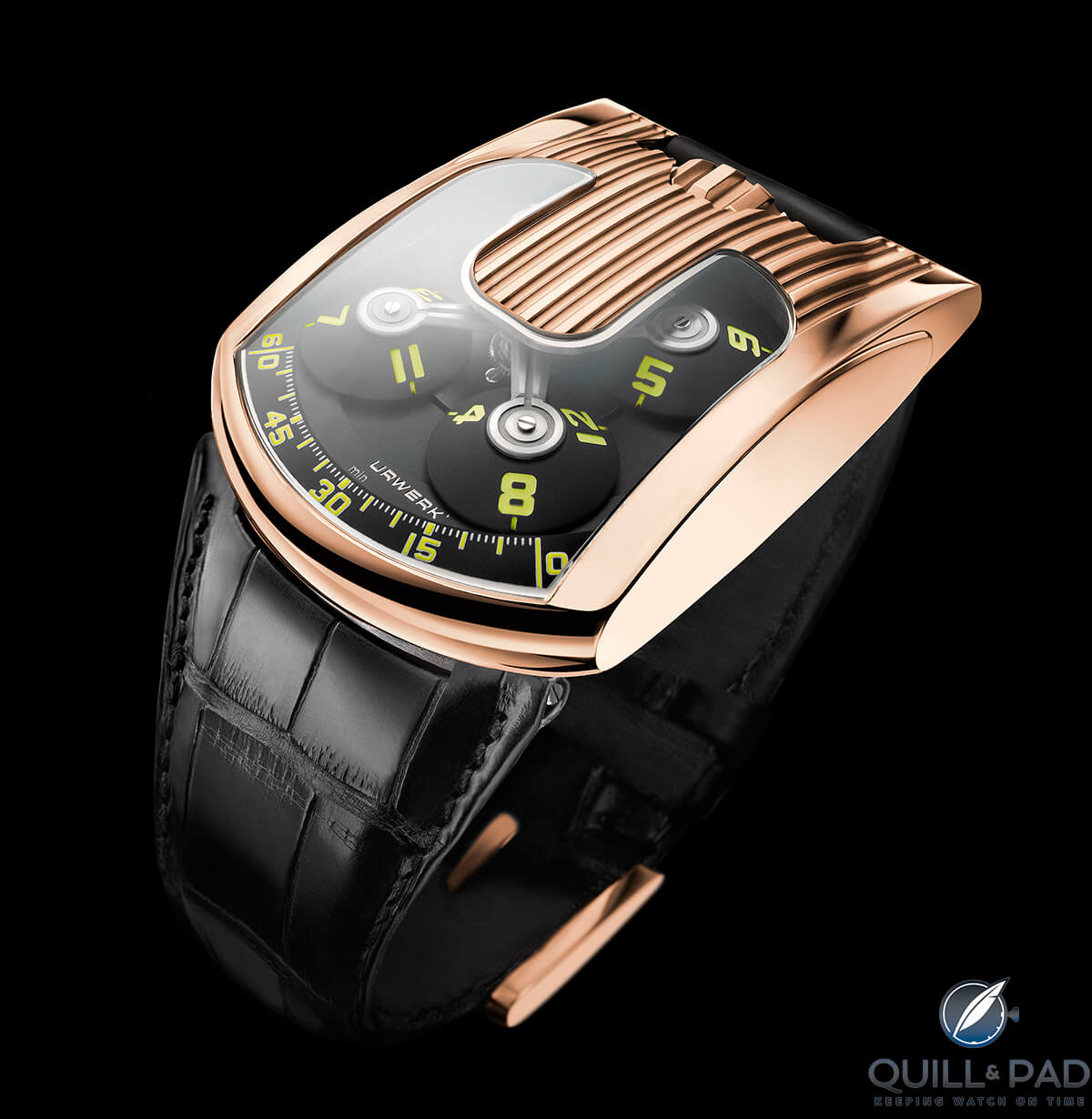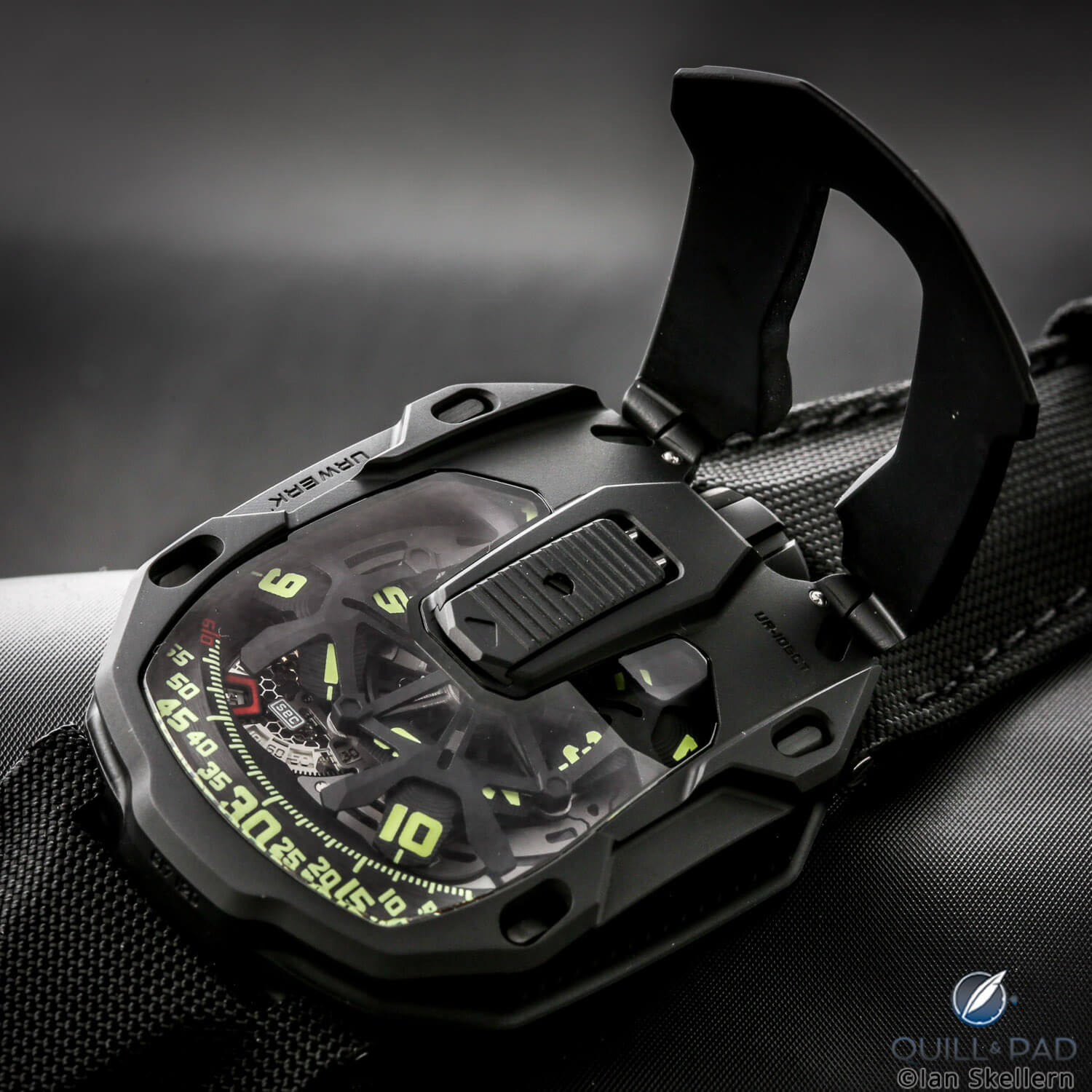by Ian Skellern
Urwerk and MB&F are two stalwarts of contemporary watchmaking with, superficially at least, much in common. Here I’ll share what I think are the significant similarities and differences between these two leaders of modern watchmaking.

Urwerk UR-T8 (left) and MB&F HM6 Alien Nation
Urwerk vs. MB&F: raison d’être
Despite their shared “futuristic” visual similarities, the basic raison d’être of Urwerk and MB&F are not just fundamentally different; they are 180 degrees opposed.
Urwerk: Felix Baumgartner, Urwerk co-founder and head technician, is a third-generation watchmaker following in the footsteps of his father and grandfather. For Baumgartner, Urwerk’s space-age designs and unusual indications are a way of breaking out of the constraints imposed by traditional haute horlogerie.

Urwerk UR-1001 Zeit Device from 2011
For Baumgartner and Urwerk co-founder and chief designer Martin Frei, Urwerk is a platform for escaping the past while remaining attached at the roots. Urwerk primarily focuses on inventing new complications; the brand’s avant-garde designs play an integral, but supporting, role to the mechanics.
MB&F: MB&F founder Maximilian Büsser isn’t trying to bust out of the constraints of haute horlogerie; with MB&F he has deliberately chosen to create his kinetic sculptures within the constraints of haute horlogerie. For the MB&F Horological Machines, design comes first, and the watchmaking serves – often quite sensationally – the design.

MB&F HM3 Star Cruiser and Sidewinder
Superlative and inventive horology is created in service to the art rather than vice versa. MB&F creates mechanical objects that tell the time, not to tell the time.
Conclusion: While Urwerk fights to bust out of the constraints of haute horlogerie, MB&F deliberately chooses to create its mechanical art within the constraints of haute horlogerie.
Urwerk vs. MB&F: history
Urwerk celebrates its twentieth anniversary in 2017, having been founded by brothers Felix and Thomas Baumgarter and artist friend Martin Frei in 1997 (Thomas left in 2004 due to health issues). The young brand scrapped by until 2003, when the launch of the UR-103 attracted the attention of then Harry Winston Rare Timepieces CEO Maximilian Büsser, which led to the 2005 presentation of the widely acclaimed Harry Winston Opus 5 and Targa-topped Urwerk UR-103.03.
With the sleek UR-103.03, Urwerk had an eye-catching model that helped the brand profit from the significant international exposure generated by creating a Harry Winston Opus.

Urwerk UR-103.03 from 2005
Over the last decade or so, Felix Baumgartner has flexed his horological credentials – always with incredibly well-styled idiosyncratic cases and dials – over a wide range of horological interests including a linear indication (UR-CC1), an uber complication (UR-1001), and an electro-mechanical hybrid (EMC) as well as the brand’s signature satellite indications (UR-105, UR-110, and UR-210).
MB&F celebrated its tenth anniversary in 2015, having been founded by Maximilian Büsser (Maximilian Büsser & Friends) in 2005 after he left Harry Winston to develop the types of watches he enjoyed creating the most modeled on the wild Opus series he had invented while at Harry Winston, which created exciting horology in collaboration with others.

MB&F Horological Machine No.1 from 2006
MB&F has a clear path in that it is a platform for Büsser’s fervent and creative imagination. While his whole career had been spent working in haute horlogerie, Büsser was not a watchmaker – and not unlike Urwerk’s Frei, has the advantage of not knowing so much that it impedes design. The options are more numerous when you don’t know what’s supposed to be impossible.
While design-led, MB&F takes its watchmaking extremely seriously as the brand wants to be (and is) considered a viable option for serious watches collectors. Not only are all of MB&F’s movements hand-finished to the nth degree, the movement (and case) architecture continually pushes the very limits of manufacturing capabilities.
And in the case of the LM Perpetual, which was developed in collaboration with Irish watchmaker Stephen McDonnell, this approach has revolutionized the prestigious complication.
Urwerk vs. MB&F: design
One notable similarity about MB&F and Urwerk is that while the case shapes (except for MB&F’s Legacy Machines) are usually completely, or even widely, different between collections in both brands, even a casual observer is likely to be able to correctly identify unfamiliar watches with the corresponding brand.
Uwerk: The designs are largely inspired by influences from Frei and Baumgartner’s youths, including Sputnik, American cars of the 1960s and ’70s, and space flight with a premium placed on legibility and readability (especially when driving).

Urwerk EMC2
Asymmetry features prominently in Urwerk’s designs as does the quest for displaying time and other indications in unusual and different ways. I consider Urwerk’s timepieces to be first high-end watches with interesting indications and complications and second (though not by far) featuring case and dial designs that many consider to be contemporary art.
MB&F: As with Frei and Baumgartner at Urwerk, Büsser’s inspirations also come from his youth and include supercars, spacecraft, and, more recently, softer, more biological forms. While MB&F puts less of a premium on legibility – remember, these are objects that tell the time, not to tell the time – than Urwerk, Büsser is well aware of the importance of telling the time and does not sacrifice readability without much deliberation.

MB&F HM7 Aquapod Ti Blue in profile
I consider MB&F’s timepieces to be kinetic sculptures first and foremost, with interesting horological indications and complications as a secondary (though not by far) consideration.
I should also stress that both Urwerk and MB&F design and develop both case and movement architecture concurrently. These pieces are too complex to approach their creation processes separately.
Urwerk vs. MB&F: future
Interestingly, there are no plans that I’m aware of by either Urwerk or MB&F to increase brand turnover or market share, each for slightly different, but basically similar, reasons.
Urwerk: Felix Baumgartner sees himself as a watchmaker rather than a brand manager and has no interest in growing Urwerk to a size where he is fulltime overseeing staff with little time to think. Baumgartner is comfortable with the size Urwerk is now, which is producing around 200 watches a year. The brand tends to bring out a completely new watch and movement every two years, so there is less pressure of always being in the news with something new.

Urwerk UR-105 CT with flip up cover
I expect to see an exciting new development from Urwerk in 2018 and am looking forward to the upcoming collaboration of Urwerk and Greubel Forsey under the auspices of the Time Aeon Foundation.
MB&F: Maximilian Büsser has no interest in growing MB&F beyond the Urwerk-like size of approximately 200 watches per year. But the reason for Büsser’s reluctance to grow is that he feels that any larger and the human dimension he enjoys is likely to be lost; he would then be more likely to have to work with people he would prefer not to.

MB&F LM2 in platinium
However, while I do not see Büsser growing MB&F, I think he is too much of an entrepreneur not to expand in other ways, and we may see him open up new avenues of creativity (and commerce) like the MB&F M.A.D.Galleries. And we are sure to see more astonishing Machines from MB&F in 2018.
For more information, please visit www.urwerk.com and/or www.mbandf.com.
* This article was first published on December 5, 2017 at Urwerk Vs. MB&F: How Do They Square Up?
You may also enjoy:
Urwerk
If You’ve Ever Wondered What The Lovechild Of A Reverso And A Tyrannosaurus Rex Might Look Like: Presenting The Urwerk UR-T8 ‘Transformer’ (Live Photos + Video)
Urwerk Celebrates 20th Anniversary In 2017: But For Me The Brand Really Blasted Off In 2005 With Harry Winston Opus V And UR-103.03
Felix Baumgartner, Urwerk, Harry Winston, And The Opus V: Where On Earth Did That Come From? Plus UR-103.03 User Review
MB&F
Why Legacy Machine Perpetual Catapults MB&F Into The Big League
Medusa In The Sea: Introducing The MB&F Horological Machine No. 7 Aquapod (Live Photos And WristShots)
The Magic Is In What You Don’t See: MB&F Destination Moon Clock With L’Epée 1839





















































Leave a Reply
Want to join the discussion?Feel free to contribute!